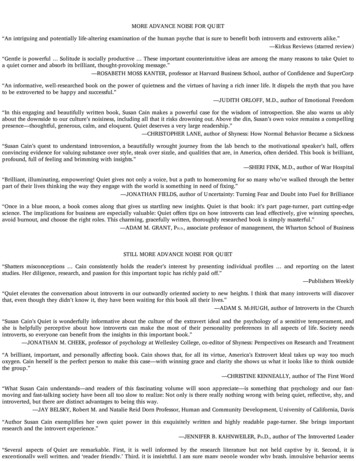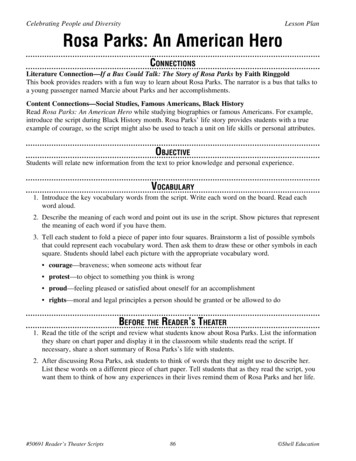
Transcription
MORE ADVANCE NOISE FOR QUIET“An intriguing and potentially life-altering examination of the human psyche that is sure to benefit both introverts and extroverts alike.”—Kirkus Reviews (starred review)“Gentle is powerful Solitude is socially productive These important counterintuitive ideas are among the many reasons to take Quiet toa quiet corner and absorb its brilliant, thought-provoking message.”—ROSABETH MOSS KANTER, professor at Harvard Business School, author of Confidence and SuperCorp“An informative, well-researched book on the power of quietness and the virtues of having a rich inner life. It dispels the myth that you haveto be extroverted to be happy and successful.”—JUDITH ORLOFF, M.D., author of Emotional Freedom“In this engaging and beautifully written book, Susan Cain makes a powerful case for the wisdom of introspection. She also warns us ablyabout the downside to our culture’s noisiness, including all that it risks drowning out. Above the din, Susan’s own voice remains a compellingpresence—thoughtful, generous, calm, and eloquent. Quiet deserves a very large readership.”—CHRISTOPHER LANE, author of Shyness: How Normal Behavior Became a Sickness“Susan Cain’s quest to understand introversion, a beautifully wrought journey from the lab bench to the motivational speaker’s hall, o ersconvincing evidence for valuing substance over style, steak over sizzle, and qualities that are, in America, often derided. This book is brilliant,profound, full of feeling and brimming with insights.”—SHERI FINK, M.D., author of War Hospital“Brilliant, illuminating, empowering! Quiet gives not only a voice, but a path to homecoming for so many who’ve walked through the betterpart of their lives thinking the way they engage with the world is something in need of fixing.”—JONATHAN FIELDS, author of Uncertainty: Turning Fear and Doubt into Fuel for Brilliance“Once in a blue moon, a book comes along that gives us startling new insights. Quiet is that book: it’s part page-turner, part cutting-edgescience. The implications for business are especially valuable: Quiet o ers tips on how introverts can lead e ectively, give winning speeches,avoid burnout, and choose the right roles. This charming, gracefully written, thoroughly researched book is simply masterful.”—ADAM M. GRANT, PH.D., associate professor of management, the Wharton School of BusinessSTILL MORE ADVANCE NOISE FOR QUIET“Shatters misconceptions Cain consistently holds the reader’s interest by presenting individual pro les and reporting on the lateststudies. Her diligence, research, and passion for this important topic has richly paid off.”—Publishers Weekly“Quiet elevates the conversation about introverts in our outwardly oriented society to new heights. I think that many introverts will discoverthat, even though they didn’t know it, they have been waiting for this book all their lives.”—ADAM S. MCHUGH, author of Introverts in the Church“Susan Cain’s Quiet is wonderfully informative about the culture of the extravert ideal and the psychology of a sensitive temperament, andshe is helpfully perceptive about how introverts can make the most of their personality preferences in all aspects of life. Society needsintroverts, so everyone can benefit from the insights in this important book.”—JONATHAN M. CHEEK, professor of psychology at Wellesley College, co-editor of Shyness: Perspectives on Research and Treatment“A brilliant, important, and personally a ecting book. Cain shows that, for all its virtue, America’s Extrovert Ideal takes up way too muchoxygen. Cain herself is the perfect person to make this case—with winning grace and clarity she shows us what it looks like to think outsidethe group.”—CHRISTINE KENNEALLY, author of The First Word“What Susan Cain understands—and readers of this fascinating volume will soon appreciate—is something that psychology and our fastmoving and fast-talking society have been all too slow to realize: Not only is there really nothing wrong with being quiet, re ective, shy, andintroverted, but there are distinct advantages to being this way.—JAY BELSKY, Robert M. and Natalie Reid Dorn Professor, Human and Community Development, University of California, Davis“Author Susan Cain exempli es her own quiet power in this exquisitely written and highly readable page-turner. She brings importantresearch and the introvert experience.”—JENNIFER B. KAHNWEILER, PH.D., author of The Introverted Leader“Several aspects of Quiet are remarkable. First, it is well informed by the research literature but not held captive by it. Second, it isexceptionally well written, and ‘reader friendly.’ Third, it is insightful. I am sure many people wonder why brash, impulsive behavior seems
exceptionally well written, and ‘reader friendly.’ Third, it is insightful. I am sure many people wonder why brash, impulsive behavior seemsto be rewarded, whereas re ective, thoughtful behavior is overlooked. This book goes beyond such super cial impressions to a morepenetrating analysis.”—WILLIAM GRAZIANO, professor, Department of Psychological Sciences, Purdue University
Copyright 2012 by Susan CainAll rights reserved.Published in the United States by Crown Publishers, an imprint of the CrownPublishing Group, a division of Random House, Inc., New York.www.crownpublishing.comCROWN and the Crown colophon are registered trademarks of Random House, Inc.The BIS/BAS Scales on this page–this page copyright 1994 by the American Psychological Association. Adapted with permission. From “Behavioral Inhibition, Behavioral Activation,and A ective Responses to Impending Reward and Punishment: The BIS/BAS Scales.” Journal of Personality and Social Psychology 67(2): 319–33. The use of APA information doesnot imply endorsement by APA.Library of Congress Cataloging-in-Publication DataCain, Susan.Quiet : the power of introverts in a world that can’t stop talking / Susan Cain.—1st ed.p. cm.1. Introverts. 2. Introversion. 3. Extroversion. 4. Interpersonal relations. I. Title.BF698.35.I59C35 2012155.2′32—dc222010053204eISBN: 978-0-307-45220-7Jacket design by Laura DuffyJacket photography by Joe Ginsberg/Getty Imagesv3.1
To my childhood family
A species in which everyone was General Patton would not succeed, any more than would a race in which everyone was Vincent van Gogh. Iprefer to think that the planet needs athletes, philosophers, sex symbols, painters, scientists; it needs the warmhearted, the hardhearted, thecoldhearted, and the weakhearted. It needs those who can devote their lives to studying how many droplets of water are secreted by thesalivary glands of dogs under which circumstances, and it needs those who can capture the passing impression of cherry blossoms in afourteen-syllable poem or devote twenty- ve pages to the dissection of a small boy’s feelings as he lies in bed in the dark waiting for hismother to kiss him goodnight. Indeed the presence of outstanding strengths presupposes that energy needed in other areas has beenchanneled away from them.—ALLEN SHAWN
Contents
ContentsCoverTitle PageCopyrightDedicationEpigraphAuthor’s NoteINTRODUCTION: The North and South of TemperamentPART ONE: THE EXTROVERT IDEAL1. THE RISE OF THE “MIGHTY LIKEABLE FELLOW”: How Extroversion Became the Cultural Ideal2. THE MYTH OF CHARISMATIC LEADERSHIP: The Culture of Personality, a Hundred Years Later3. WHEN COLLABORATION KILLS CREATIVITY: The Rise of the New Groupthink and the Power of Working AlonePART TWO: YOUR BIOLOGY, YOUR SELF?4. IS TEMPERAMENT DESTINY?: Nature, Nurture, and the Orchid Hypothesis5. BEYOND TEMPERAMENT: The Role of Free Will (and the Secret of Public Speaking for Introverts)6. “FRANKLIN WAS A POLITICIAN, BUT ELEANOR SPOKE OUT OF CONSCIENCE”: Why Cool Is Overrated7. WHY DID WALL STREET CRASH AND WARREN BUFFETT PROSPER?: How Introverts and Extroverts Think (and Process Dopamine) DifferentlyPART THREE: DO ALL CULTURES HAVE AN EXTROVERT IDEAL?8. SOFT POWER: Asian-Americans and the Extrovert IdealPART FOUR: HOW TO LOVE, HOW TO WORK9. WHEN SHOULD YOU ACT MORE EXTROVERTED THAN YOU REALLY ARE?10. THE COMMUNICATION GAP: How to Talk to Members of the Opposite Type11. ON COBBLERS AND GENERALS: How to Cultivate Quiet Kids in a World That Can’t Hear ThemCONCLUSION: WonderlandA Note on the DedicationA Note on the Words Introvert and ExtrovertAcknowledgmentsNotes
Author’s Note
Author’s NoteI have been working on this book o cially since 2005, and uno cially for my entire adult life. I have spoken and written to hundreds,perhaps thousands, of people about the topics covered inside, and have read as many books, scholarly papers, magazine articles, chat-roomdiscussions, and blog posts. Some of these I mention in the book; others informed almost every sentence I wrote. Quiet stands on manyshoulders, especially the scholars and researchers whose work taught me so much. In a perfect world, I would have named every one of mysources, mentors, and interviewees. But for the sake of readability, some names appear only in the Notes or Acknowledgments.For similar reasons, I did not use ellipses or brackets in certain quotations but made sure that the extra or missing words did not changethe speaker’s or writer’s meaning. If you would like to quote these written sources from the original, the citations directing you to the fullquotations appear in the Notes.I’ve changed the names and identifying details of some of the people whose stories I tell, and in the stories of my own work as a lawyerand consultant. To protect the privacy of the participants in Charles di Cagno’s public speaking workshop, who did not plan to be includedin a book when they signed up for the class, the story of my rst evening in class is a composite based on several sessions; so is the story ofGreg and Emily, which is based on many interviews with similar couples. Subject to the limitations of memory, all other stories arerecounted as they happened or were told to me. I did not fact-check the stories people told me about themselves, but only included those Ibelieved to be true.
INTRODUCTION
INTRODUCTIONThe North and South of TemperamentMontgomery, Alabama. December 1, 1955. Early evening. A public bus pulls to a stop and a sensibly dressed woman in her forties gets on.She carries herself erectly, despite having spent the day bent over an ironing board in a dingy basement tailor shop at the Montgomery Fairdepartment store. Her feet are swollen, her shoulders ache. She sits in the rst row of the Colored section and watches quietly as the bus llswith riders. Until the driver orders her to give her seat to a white passenger.The woman utters a single word that ignites one of the most important civil rights protests of the twentieth century, one word that helpsAmerica find its better self.The word is “No.”The driver threatens to have her arrested.“You may do that,” says Rosa Parks.A police officer arrives. He asks Parks why she won’t move.“Why do you all push us around?” she answers simply.“I don’t know,” he says. “But the law is the law, and you’re under arrest.”On the afternoon of her trial and conviction for disorderly conduct, the Montgomery Improvement Association holds a rally for Parks at theHolt Street Baptist Church, in the poorest section of town. Five thousand gather to support Parks’s lonely act of courage. They squeeze insidethe church until its pews can hold no more. The rest wait patiently outside, listening through loudspeakers. The Reverend Martin Luther KingJr. addresses the crowd. “There comes a time that people get tired of being trampled over by the iron feet of oppression,” he tells them.“There comes a time when people get tired of being pushed out of the glittering sunlight of life’s July and left standing amidst the piercingchill of an Alpine November.”He praises Parks’s bravery and hugs her. She stands silently, her mere presence enough to galvanize the crowd. The association launches acity-wide bus boycott that lasts 381 days. The people trudge miles to work. They carpool with strangers. They change the course of Americanhistory.I had always imagined Rosa Parks as a stately woman with a bold temperament, someone who could easily stand up to a busload ofglowering passengers. But when she died in 2005 at the age of ninety-two, the ood of obituaries recalled her as soft-spoken, sweet, andsmall in stature. They said she was “timid and shy” but had “the courage of a lion.” They were full of phrases like “radical humility” and“quiet fortitude.” What does it mean to be quiet and have fortitude? these descriptions asked implicitly. How could you be shy andcourageous?Parks herself seemed aware of this paradox, calling her autobiography Quiet Strength—a title that challenges us to question ourassumptions. Why shouldn’t quiet be strong? And what else can quiet do that we don’t give it credit for?Our lives are shaped as profoundly by personality as by gender or race. And the single most important aspect of personality—the “north andsouth of temperament,” as one scientist puts it—is where we fall on the introvert-extrovert spectrum. Our place on this continuum in uencesour choice of friends and mates, and how we make conversation, resolve di erences, and show love. It a ects the careers we choose andwhether or not we succeed at them. It governs how likely we are to exercise, commit adultery, function well without sleep, learn from ourmistakes, place big bets in the stock market, delay grati cation, be a good leader, and ask “what if.”* It’s re ected in our brain pathways,neurotransmitters, and remote corners of our nervous systems. Today introversion and extroversion are two of the most exhaustivelyresearched subjects in personality psychology, arousing the curiosity of hundreds of scientists.These researchers have made exciting discoveries aided by the latest technology, but they’re part of a long and storied tradition. Poets andphilosophers have been thinking about introverts and extroverts since the dawn of recorded time. Both personality types appear in the Bibleand in the writings of Greek and Roman physicians, and some evolutionary psychologists say that the history of these types reaches back evenfarther than that: the animal kingdom also boasts “introverts” and “extroverts,” as we’ll see, from fruit ies to pumpkinseed sh to rhesusmonkeys. As with other complementary pairings—masculinity and femininity, East and West, liberal and conservative—humanity would beunrecognizable, and vastly diminished, without both personality styles.Take the partnership of Rosa Parks and Martin Luther King Jr.: a formidable orator refusing to give up his seat on a segregated buswouldn’t have had the same e ect as a modest woman who’d clearly prefer to keep silent but for the exigencies of the situation. And Parksdidn’t have the stuff to thrill a crowd if she’d tried to stand up and announce that she had a dream. But with King’s help, she didn’t have to.Yet today we make room for a remarkably narrow range of personality styles. We’re told that to be great is to be bold, to be happy is to besociable. We see ourselves as a nation of extroverts—which means that we’ve lost sight of who we really are. Depending on which study youconsult, one third to one half of Americans are introverts—in other words, one out of every two or three people you know. (Given that theUnited States is among the most extroverted of nations, the number must be at least as high in other parts of the world.) If you’re not anintrovert yourself, you are surely raising, managing, married to, or coupled with one.If these statistics surprise you, that’s probably because so many people pretend to be extroverts. Closet introverts pass undetected onplaygrounds, in high school locker rooms, and in the corridors of corporate America. Some fool even themselves, until some life event—alayo , an empty nest, an inheritance that frees them to spend time as they like—jolts them into taking stock of their true natures. You haveonly to raise the subject of this book with your friends and acquaintances to nd that the most unlikely people consider themselvesintroverts.It makes sense that so many introverts hide even from themselves. We live with a value system that I call the Extrovert Ideal—theomnipresent belief that the ideal self is gregarious, alpha, and comfortable in the spotlight. The archetypal extrovert prefers action tocontemplation, risk-taking to heed-taking, certainty to doubt. He favors quick decisions, even at the risk of being wrong. She works well inteams and socializes in groups. We like to think that we value individuality, but all too often we admire one type of individual—the kindwho’s comfortable “putting himself out there.” Sure, we allow technologically gifted loners who launch companies in garages to have any
who’s comfortable “putting himself out there.” Sure, we allow technologically gifted loners who launch companies in garages to have anypersonality they please, but they are the exceptions, not the rule, and our tolerance extends mainly to those who get fabulously wealthy orhold the promise of doing so.Introversion—along with its cousins sensitivity, seriousness, and shyness—is now a second-class personality trait, somewhere between adisappointment and a pathology. Introverts living under the Extrovert Ideal are like women in a man’s world, discounted because of a traitthat goes to the core of who they are. Extroversion is an enormously appealing personality style, but we’ve turned it into an oppressivestandard to which most of us feel we must conform.The Extrovert Ideal has been documented in many studies, though this research has never been grouped under a single name. Talkativepeople, for example, are rated as smarter, better-looking, more interesting, and more desirable as friends. Velocity of speech counts as wellas volume: we rank fast talkers as more competent and likable than slow ones. The same dynamics apply in groups, where research showsthat the voluble are considered smarter than the reticent—even though there’s zero correlation between the gift of gab and good ideas. Eventhe word introvert is stigmatized—one informal study, by psychologist Laurie Helgoe, found that introverts described their own physicalappearance in vivid language (“green-blue eyes,” “exotic,” “high cheekbones”), but when asked to describe generic introverts they drew abland and distasteful picture (“ungainly,” “neutral colors,” “skin problems”).But we make a grave mistake to embrace the Extrovert Ideal so unthinkingly. Some of our greatest ideas, art, and inventions—from thetheory of evolution to van Gogh’s sun owers to the personal computer—came from quiet and cerebral people who knew how to tune in totheir inner worlds and the treasures to be found there. Without introverts, the world would be devoid of:the theory of gravitythe theory of relativityW. B. Yeats’s “The Second Coming”Chopin’s nocturnesProust’s In Search of Lost TimePeter PanOrwell’s Nineteen Eighty-Four and Animal FarmThe Cat in the HatCharlie BrownSchindler’s List, E.T., and Close Encounters of the Third KindGoogleHarry Potter*As the science journalist Winifred Gallagher writes: “The glory of the disposition that stops to consider stimuli rather than rushing toengage with them is its long association with intellectual and artistic achievement. Neither E mc2 nor Paradise Lost was dashed o by aparty animal.” Even in less obviously introverted occupations, like nance, politics, and activism, some of the greatest leaps forward weremade by introverts. In this book we’ll see how gures like Eleanor Roosevelt, Al Gore, Warren Bu ett, Gandhi—and Rosa Parks—achievedwhat they did not in spite of but because of their introversion.Yet, as Quiet will explore, many of the most important institutions of contemporary life are designed for those who enjoy group projectsand high levels of stimulation. As children, our classroom desks are increasingly arranged in pods, the better to foster group learning, andresearch suggests that the vast majority of teachers believe that the ideal student is an extrovert. We watch TV shows whose protagonists arenot the “children next door,” like the Cindy Bradys and Beaver Cleavers of yesteryear, but rock stars and webcast hostesses with outsizedpersonalities, like Hannah Montana and Carly Shay of iCarly. Even Sid the Science Kid, a PBS-sponsored role model for the preschool set,kicks off each school day by performing dance moves with his pals. (“Check out my moves! I’m a rock star!”)As adults, many of us work for organizations that insist we work in teams, in o ces without walls, for supervisors who value “peopleskills” above all. To advance our careers, we’re expected to promote ourselves unabashedly. The scientists whose research gets funded oftenhave con dent, perhaps overcon dent, personalities. The artists whose work adorns the walls of contemporary museums strike impressiveposes at gallery openings. The authors whose books get published—once accepted as a reclusive breed—are now vetted by publicists tomake sure they’re talk-show ready. (You wouldn’t be reading this book if I hadn’t convinced my publisher that I was enough of a pseudoextrovert to promote it.)If you’re an introvert, you also know that the bias against quiet can cause deep psychic pain. As a child you might have overheard yourparents apologize for your shyness. (“Why can’t you be more like the Kennedy boys?” the Camelot-besotted parents of one man I interviewedrepeatedly asked him.) Or at school you might have been prodded to come “out of your shell”—that noxious expression which fails toappreciate that some animals naturally carry shelter everywhere they go, and that some humans are just the same. “All the comments fromchildhood still ring in my ears, that I was lazy, stupid, slow, boring,” writes a member of an e-mail list called Introvert Retreat. “By the time Iwas old enough to gure out that I was simply introverted, it was a part of my being, the assumption that there is something inherentlywrong with me. I wish I could find that little vestige of doubt and remove it.”Now that you’re an adult, you might still feel a pang of guilt when you decline a dinner invitation in favor of a good book. Or maybe youlike to eat alone in restaurants and could do without the pitying looks from fellow diners. Or you’re told that you’re “in your head toomuch,” a phrase that’s often deployed against the quiet and cerebral.Of course, there’s another word for such people: thinkers.I have seen firsthand how difficult it is for introverts to take stock of their own talents, and how powerful it is when finally they do. For morethan ten years I trained people of all stripes—corporate lawyers and college students, hedge-fund managers and married couples—innegotiation skills. Of course, we covered the basics: how to prepare for a negotiation, when to make the rst o er, and what to do when theother person says “take it or leave it.” But I also helped clients figure out their natural personalities and how to make the most of them.My very rst client was a young woman named Laura. She was a Wall Street lawyer, but a quiet and daydreamy one who dreaded thespotlight and disliked aggression. She had managed somehow to make it through the crucible of Harvard Law School—a place where classes
are conducted in huge, gladiatorial amphitheaters, and where she once got so nervous that she threw up on the way to class. Now that shewas in the real world, she wasn’t sure she could represent her clients as forcefully as they expected.For the rst three years on the job, Laura was so junior that she never had to test this premise. But one day the senior lawyer she’d beenworking with went on vacation, leaving her in charge of an important negotiation. The client was a South American manufacturing companythat was about to default on a bank loan and hoped to renegotiate its terms; a syndicate of bankers that owned the endangered loan sat onthe other side of the negotiating table.Laura would have preferred to hide under said table, but she was accustomed to ghting such impulses. Gamely but nervously, she tookher spot in the lead chair, anked by her clients: general counsel on one side and senior nancial o cer on the other. These happened to beLaura’s favorite clients: gracious and soft-spoken, very di erent from the master-of-the-universe types her rm usually represented. In thepast, Laura had taken the general counsel to a Yankees game and the nancial o cer shopping for a handbag for her sister. But now thesecozy outings—just the kind of socializing Laura enjoyed—seemed a world away. Across the table sat nine disgruntled investment bankers intailored suits and expensive shoes, accompanied by their lawyer, a square-jawed woman with a hearty manner. Clearly not the self-doubtingtype, this woman launched into an impressive speech on how Laura’s clients would be lucky simply to accept the bankers’ terms. It was, shesaid, a very magnanimous offer.Everyone waited for Laura to reply, but she couldn’t think of anything to say. So she just sat there. Blinking. All eyes on her. Her clientsshifting uneasily in their seats. Her thoughts running in a familiar loop: I’m too quiet for this kind of thing, too unassuming, too cerebral. Sheimagined the person who would be better equipped to save the day: someone bold, smooth, ready to pound the table. In middle school thisperson, unlike Laura, would have been called “outgoing,” the highest accolade her seventh-grade classmates knew, higher even than “pretty,”for a girl, or “athletic,” for a guy. Laura promised herself that she only had to make it through the day. Tomorrow she would go look foranother career.Then she remembered what I’d told her again and again: she was an introvert, and as such she had unique powers in negotiation—perhapsless obvious but no less formidable. She’d probably prepared more than everyone else. She had a quiet but rm speaking style. She rarelyspoke without thinking. Being mild-mannered, she could take strong, even aggressive, positions while coming across as perfectly reasonable.And she tended to ask questions—lots of them—and actually listen to the answers, which, no matter what your personality, is crucial tostrong negotiation.So Laura finally started doing what came naturally.“Let’s go back a step. What are your numbers based on?” she asked.“What if we structured the loan this way, do you think it might work?”“That way?”“Some other way?”At rst her questions were tentative. She picked up steam as she went along, posing them more forcefully and making it clear that she’ddone her homework and wouldn’t concede the facts. But she also stayed true to her own style, never raising her voice or losing her decorum.Every time the bankers made an assertion that seemed unbudgeable, Laura tried to be constructive. “Are you saying that’s the only way to go?What if we took a different approach?”Eventually her simple queries shifted the mood in the room, just as the negotiation textbooks say they will. The bankers stoppedspeechifying and dominance-posing, activities for which Laura felt hopelessly ill-equipped, and they started having an actual conversation.More discussion. Still no agreement. One of the bankers revved up again, throwing his papers down and storming out of the room. Lauraignored this display, mostly because she didn’t know what else to do. Later on someone told her that at that pivotal moment she’d played agood game of something called “negotiation jujitsu”; but she knew that she was just doing what you learn to do naturally as a quiet person ina loudmouth world.Finally the two sides struck a deal. The bankers left the building, Laura’s favorite clients headed for the airport, and Laura went home,curled up with a book, and tried to forget the day’s tensions.But the next morning, the lead lawyer for the bankers—the vigorous woman with the strong jaw—called to o er her a job. “I’ve never seenanyone so nice and so tough at the same time,” she said. And the day after that, the lead banker called Laura, asking if her law rm wouldrepresent his company in the future. “We need someone who can help us put deals together without letting ego get in the way,” he said.By sticking to her own gentle way of doing things, Laura had reeled in new business for her rm and a job o er for herself. Raising hervoice and pounding the table was unnecessary.Today Laura understands that her introversion is an essential part of who she is, and she embraces her re ective nature. The loop insideher head that accused her of being too quiet and unassuming plays much less often. Laura knows that she can hold her own when she needsto.What exactly do I mean when I say that Laura is an introvert? When I started writing this book, the rst thing I wanted to nd out wasprecisely how researchers de ne introversion and extroversion. I knew that in 1921 the in uential psychologist Carl Jung had published abombshell of a book, Psychological Types, popularizing the terms introvert and extrovert as the central building blocks of personality.Introverts are drawn to the inner world of thought and feeling, said Jung, extroverts to the external life of people and activities. Introvertsfocus on the meaning they make of the events swirling around them; extroverts plunge into the events themselves. Introverts recharge theirbatteries by being alone; extroverts need to recharge when they don’t socialize enough. If you’ve ever taken a Myers-Briggs personality test,which is based on Jung’s thinking and used by the majority of universities and Fortune 100 companies, then you may already be familiarwith these ideas.But what do contemporary researchers have to say? I soon discovered that there is no all-purpose de nition of introversion or extroversion;these are not unitary categories, like “curly-haired” or “sixteen-year-old,” in which everyone can agree on who quali es for inclusion. Forexample, adherents of the Big
Cain, Susan. Quiet : the power of introverts in a world that can’t stop talking / Susan Cain.—1st ed. p. cm. 1. Introverts. 2. Introversion. 3. Extroversion. 4. Interpersonal relations. I. Title. BF698.35.I59C35 2012 155.2′32—dc22 2010053204 eISBN: 978-0-307-45220-7 Jacket design by










